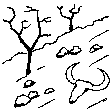



This technology is a restoration technology implemented on ravines and gullies in a degraded semiarid mountain range. The restoration technology consisted of a plantation of seedlings of a variety of native woody species, mostly shrubs, on terraces with stone walls. Using planting holes, one or two rows of seedlings were established on each terrace; Seedlings were protected from extreme radiation and predation by biodegradable seedling shelters. The target area was highly degraded due to long-term overexploitation of resources under harsh environmental conditions. Failed previous reforestation actions on bench terraces led to further degradation in some areas. Degradation resulted in lack of riparian vegetation on the ramblas (ravines with intermittent flow), soil erosion, development of gullies, and frequent floods. To address this problem, the Forest Administration implemented a restoration program on the ravines and gullies of the south-facing side of the Albatera-Crevillente mountain range. The program was implemented in 2006-07.
Purpose of the Technology: The purpose of the restoration was control of concentrated erosion in gullies and ravines; mitigation of landscape degradation; flood prevention; restoration of diversity and cover of vegetation on a degraded semiarid mountain range.
Natural / human environment: The target area is the south-facing side of a mountain range in a semiarid area of Southeast Spain. Exploitation of resources over centuries, mostly grazing and wood gathering, under harsh environmental conditions, led to very low plant cover, mostly consisting of dwarf shrubs sparsed in a matrix of bare soil, lack of riparian vegetation on the ramblas (ravines with intermittent flow), soil erosion, development of gullies, and frequent floods. The exploitation of the land was drastically reduced during the second half of the XXth century due to the general rural land abandonment trend that started in Spain around the 1950’s driven by critical socio-economic changes such as the use of fossil fuels and the sharp increase in activity in the tourism and services business sectors, mostly in the coast land. However, despite the reduction, or even complete abandonment, of rural activity on the mountain range area, there was no sign of spontaneous recovery from degradation. Soil erosion and floods were of major concern for the resource managers in the area (Public Forest Administration), and a number of reforestation and restoration programs have been implemented in the area, with varying degree of success. In more recent decades, new pressures appeared in the mountain area, such as agricultural expansion into the range area (1970s), mining activities (late 1990’s - early 2000’s), and urbanization (2000s). Rural tourism and recreation are new activities in the mountain range area. For the time being, the intensity of these activities is low to moderate. However there is already some evidence of incipient degradation associated to recreation, and some regulation is being demanded by environmental NGOs
Location: Albatera, Spain/Alicante, Spain
No. of Technology sites analysed:
Spread of the Technology: evenly spread over an area (approx. 1-10 km2)
In a permanently protected area?:
Date of implementation: less than 10 years ago (recently)
Type of introduction







| Specify input | Unit | Quantity | Costs per Unit (Euro) | Total costs per input (Euro) | % of costs borne by land users |
| Labour | |||||
| Labour | ha | 1.0 | 1796.0 | 1796.0 | 100.0 |
| Equipment | |||||
| Machine use | ha | 1.0 | 853.0 | 853.0 | 100.0 |
| Plant material | |||||
| Seedlings | ha | 1.0 | 252.0 | 252.0 | 100.0 |
| Fertilizers and biocides | |||||
| Compost/manure | ha | 1.0 | 154.0 | 154.0 | 100.0 |
| Other | |||||
| Three shelters | ha | 1.0 | 424.0 | 424.0 | 100.0 |
| Total costs for establishment of the Technology | 3'479.0 | ||||
| Total costs for establishment of the Technology in USD | 4'403.8 | ||||
Recreational use